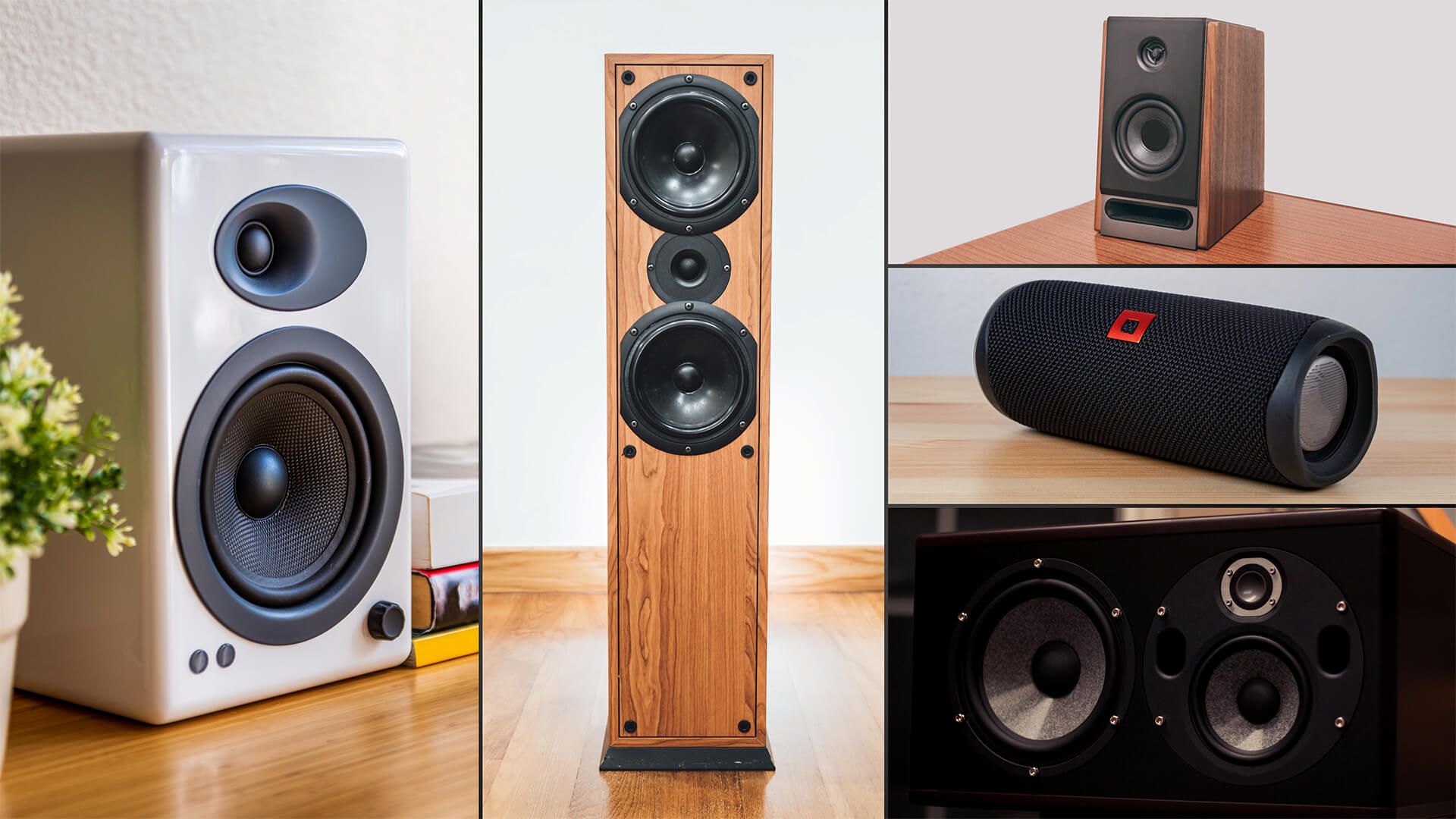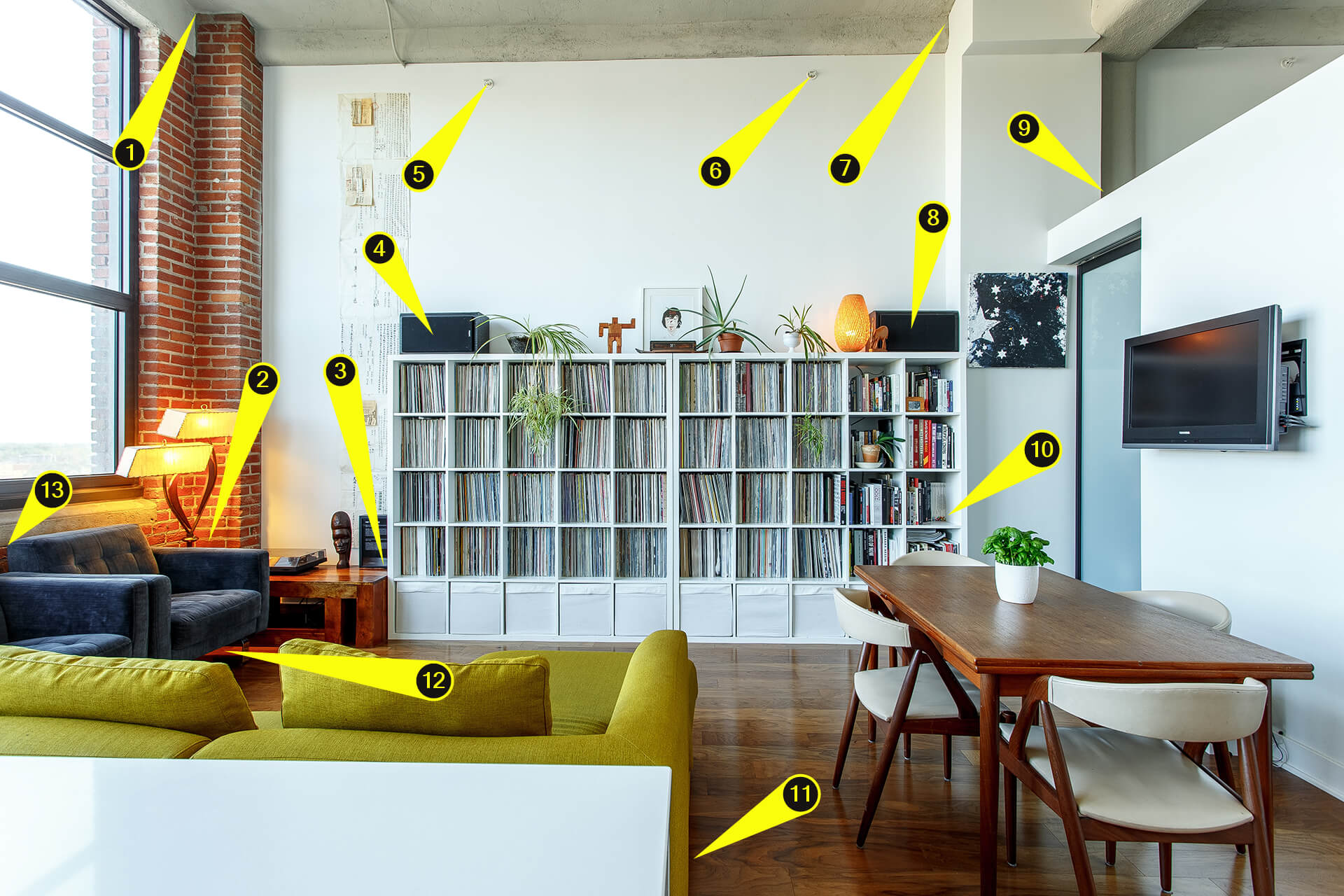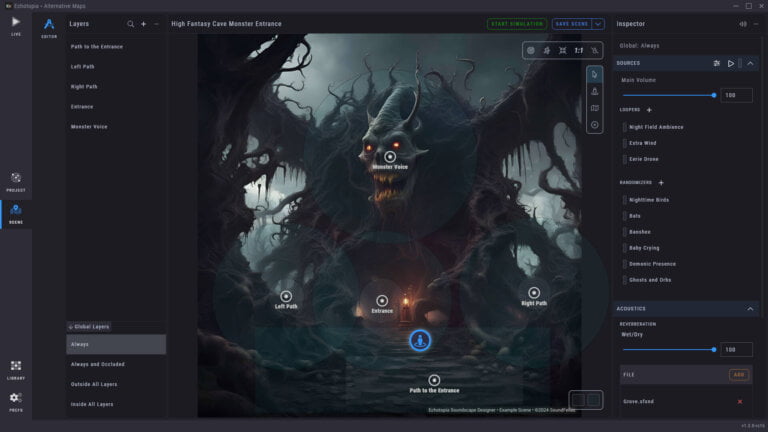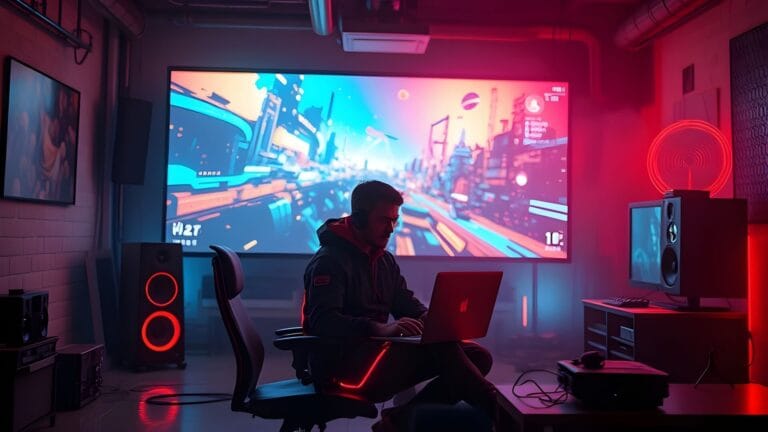Introduction
One of the things a game room will need to become truly immersive is speakers. In this article, we’re looking at various speakers, and use simple reasoning to help you choose which ones are simple to connect, set up, and won’t break the bank, in order to provide you with a solid answer as to which is the best fit for your game room.
Our main pivot point in this article will be that the audio material that the speakers will playback in your game room is going to be RPG music, usually played back during DnD sessions or any other board game for the matter. Music and ambience played back for a larger-than-two audience in a typical gaming situation, is categorized as experiential audio for a group of people and the experience design is similar to that of elevator music or Muzak. That kind of playback doesn't need a precise configuration of speakers like stereo or surround sound, so keep an open mind about the freedom you have on positioning the speakers around your space, to create the best possible experience for your audience the players.
[icon name="info-circle" prefix="fal"] Info
If you’re feeling confused and don’t know where to set your speakers up for full immersion, don’t worry. You can check my other article on how to set up the sound of your game room for immersive tabletop audio in your RPG sessions, and move on from there.
Speaker categorization
That’s a speaker. And that’s a speaker. And that’s a...
An online search will return a bunch of results, but the information is pretty scattered, needs digging through and it may seem like a hassle to read through and process all that. It also can’t read your mind and give you the hands-down best choice for your setup.

So, to find the speakers destined for your immersive game room, we’re going to look at some of their characteristics such as size, connectivity, frequency range, powering, and of course price.
Buckle up. We’re going to tidy up, put things in order, and a victor shall emerge.
[icon name="pen-square" prefix="fal"] Note
This is not a buying guide or comparison of speakers based on performance and price. You will need to do your own research taking your budget and needs into account to decide what suits you best.
Categorization
Connection type
- Wired: The most common way to connect speakers to an audio signal source is wired. It is done via cables physically connecting the source’s output with the speakers’ inputs, using a variety of connectors like jacks, RCA, banana, and XLR.
- Wireless: With this method, the audio signal source and speakers need no physical connection to communicate. It can be done using either WiFi or Bluetooth. Wireless gains more and more ground in recent years, as the technology supporting it and its protocols constantly improve and become more inexpensive.
Interior or exterior use
- Interior speakers: Speakers that are built for installation ideally in indoor spaces like homes and venues. It’s not impossible to use them outside, however, they won’t be happy about it, and you’d be risking damage even over a short period of time.
- Outdoor speakers: Speakers that are built for installation outdoors. Their housings and components are able to better withstand prolonged exposure to the elements e.g. sunlight, heat, humidity, dust, salt (if near the sea), etc.
Powering method
- Passive speakers: These speakers require physical connection via cables with an amplifier to provide them with power and audio signal.
- Active speakers: Also known as self-powered speakers, these are equipped with their own amplifier and only require connection to a source for the audio signal. They are powered by plugging them directly into a wall outlet.
Drive types
A speaker enclosure, also known as a monitor, can be made with one or more drives. The drives are also known as speakers but don't worry, in this article when we say speaker we mean the full monitor.
Drive types play a big role in the frequency range the speaker can playback. In layman’s terms, frequency range, or frequency response, measures how wide in the frequency spectrum a variety of sounds a speaker can reproduce.
So based on that, a simple categorization of drive types would be:
- Full-range: These can reproduce almost the entirety of the audible spectrum, from bassy to very high sounds.
- Subwoofer (aka sub): A specialized drive that only reproduces very low, bassy sounds. It usually comes as a separate unit, but in some cases, it can be included in the speaker with the rest of the drives.
- Woofer: This drive also reproduces only lower frequencies, but has a wider range than its specialized cousin, the sub, although usually, it may not reach as low frequencies as the sub does.
- Mid-range (aka squawker): This drive reproduces frequencies in the middle of the spectrum.
- Tweeter: This little fellow reproduces only the higher frequency sounds.
- Tuned-port: This is not a drive per se, but it's very common in commercial speakers. This is an opening, usually in the front of the speaker, featuring specially designed geometry that allows it to take the movement produced from the movement on the back of the rest of the speaker's drives and drive it through the opening in the front. The specially designed geometry allows this port to playback lower frequencies than the ones that the rest of the drives are capable of reproducing. Using this clever architecture the speaker manufacturer can expand the playback capabilities of the speaker to lower frequencies using the same amount of drives and almost the same form factor.
Form factor
- Floor standing speakers (aka towers): These are tall, powerful, equipped with multiple drivers, and usually full range. They are used mostly on higher-end sound systems and home cinemas.
- Bookshelf speakers: Very common, relatively small in size, and full range. You’ll see them everywhere from cheap home hi-fi systems, to high-end configurations.
- Satellites: A small kind of speaker. Not full range, but not quite as limited in frequency response either. They reproduce mid to high frequencies and are paired with a subwoofer that takes care of the bass. They see use in home cinemas and multimedia sets, as well as standalone in the form of wireless speakers.
- Multimedia speakers (aka computer or desktop): Another very common variety, very small in size, used to connect with just about anything, from computers to mobile devices. They come in sets that feature small satellites and very often a subwoofer, to create a 2.1, 5.1, or 7.1 surround speaker set.
- Ceiling/In-wall: A specialized speaker that is installed inside walls and ceilings. Some are even waterproof so they can be put in bathrooms.
There are also hybrid form factors like satellites that can be ceiling-mounted or in-between multimedia and bookshelf designs. But you get the idea.
Phew, that was a lot of info. Are you still here? Good.
How to choose your speakers
Now that we established some taxonomy, I think we can start thinking about the solutions that would work in a game room without breaking the bank, as the title of this article promises.
Wired or wireless?
Regarding connection types, it's a dealer's choice. To help you decide, from my experience it comes down to what kind of work you like to do, and the geometry of the room.
If the room has simple geometry and you don't mind setting up some cabling around, then wired speakers would be your choice. Wired speakers will never run off from battery power and they have far better quality than wireless speakers.
If your lifestyle and room don't allow for cabling, then wireless would be your choice. Just keep in mind that wireless speakers usually need battery charging. Wireless speakers usually use the Bluetooth protocol to transmit audio, which is somehow inferior to the quality you get from cabled connections. If you go that way, a good idea is to choose the speakers that support the latest Bluetooth protocol and also support chaining many Bluetooth speakers together to cover more space with sound. That last choice will allow you to expand your audio territory if you need it later.
Interior or exterior use?
That's super easy, right? Choose the speaker according to the type of space you are creating. If it's in your back yard then exterior would be nice, but if you can set it up and gather it for each session, then you should be fine with interior type also.
Exterior type speakers are more pricey too as they contain better handling of humidity, sometimes to the level of being completely water-proof. They also can handle more aggression, if you find those with anti-vandalism features, those might be great if you are setting up a small theme park in an open space for LARPG sessions.
Powering method
Seems that the best option would be to use active speakers as they are self-contained and offer more flexibility in general.
There is one scenario in which I would prefer the passive speakers. Passive speakers don't have to integrate with a power amp inside them, so they feature smaller form factors than the active ones with the same specifications. Maybe this is something that fits your case better.
Drive types
Regarding drive types, the ideal speaker would be one that contained all the types it needed to playback full-spectrum audio. But that would be bulky and expensive, and we would have to sacrifice space coverage for audio fidelity.
And let's not forget that game rooms are spaces designed to offer entertainment to many people, so having one perfect stereo speaker set pointed towards one sweet spot would be wrong.
Our speaker should have enough drives to playback the basic frequency spectrum that would allow you to watch a movie. Something more than the speakers from a laptop and less than the speakers from an expensive HiFi.
I believe that a speaker with a woofer, a tweeter, and a tuned port would cover our game room needs.
What about the form factor?
Form factor choice depends on the way your game room is configured and the objects placed around the space.
If you need to create an immersive experience, I always support the choice of smaller form factor speakers, so you can use many chained together to create more sound field coverage around the room, which eventually will allow you to achieve better immersion with lower sound levels. This will help with the intelligibility of your storytelling and the dialog between the players, and also offer the same amount of sound energy for each participant, making this a truly social and enjoyable-by-everybody event.

What would I choose?
Well, a cleverly designed game room doesn't have to break your bank, and the content that you are going to playback on those speakers is probably designed to be heard as you listen to the audio of a videogame, while playing.
My personal preference would be multiple sets of active multimedia speakers, featuring a woofer, a tweeter, and a tuned port. I would scatter them around the room and try to point them in directions that would give them the most diffusion around my players.
Here are some of the advantages and (to be fair) some of the disadvantages of the active multimedia speaker...
Active multimedia speaker advantages
- They are small in size and lightweight. They won’t hog up space, they’re easy to move around and place, hide or even hang from the ceiling.
- They won’t break the bank. You can load up on a bunch of them and use them to increase the speaker count in one room, or set them up in another.
- Cheap also makes them expendable. You won’t cry when an overly enthusiastic reaction by a player or you randomly knocks one over and breaks it.
- They’re simple and easy to connect. Almost always all they need is a small jack or an RCA connector. Plug that into your computer, cell phone, tablet, laptop, or whatever and you’re off.
- They’re a perfect match for Echotopia, our soundscape designer application. How’s that good? You can suddenly have an entire array of speakers creating an atmosphere of calm or dread, a fantastical forest or bustling town, an epic battle in the dark ages, or the darkness of space.
- They’re (usually) self-powered speakers. This means you do not need an amplifier, which in turn saves you some money and simplifies your setup overall.
- They’re in abundance. You can find them almost everywhere and almost always in stock. Good for when you need that replacement for the speaker that was broken during a fit of enthusiasm.
- They can be found in surround sets. That’s awesome. Go grab two sets and you’re automatically sporting ten satellite speakers and two subs. Twelve speakers total, that’s a lot of coverage, read here to see how to take advantage of multiple speaker systems for one room. And if you only want one sub to be heard, no problem. Those usually have volume controls onboard.
- They come in wireless varieties as well.
[icon name="check-circle" prefix="fal"] Nerdy Tip
Multimedia speakers often have headphone outputs. So if you have many pairs you can connect an equal number of headphones for some extra quiet RPing.
Active multimedia speaker disadvantages
- They usually cannot reproduce the full frequency spectrum like more expensive speakers. That doesn't mean that multimedia speakers with adequate frequency response don't exist, a little research and some listening tests in your local store can reveal some good choices.
- You will need some extra work to daisy chain more of them, and that's gonna bring your way some extra cable work (even the wireless ones need a power plug), but the end result will be worth it.
- A lot of market noise. The active multimedia speaker market is saturated with very low-quality products and the specifications written on the box are not really accurate. You have to invest a little more time when you research for the best choice.
Alternative choices
Before wrapping up, I’m going to make a quick mention of some alternative options you might want to consider, in case you have alternative needs or want to step up your audio game (pun intended).
Active prosumer speakers
One of the types that I didn't mention already is the prosumer speakers. Yeap, that's a word. It's made from the words "professional" and "consumer" and it's used to describe the kind of equipment that is used by amateurs or hobbyists who enter a professional sector. Audio production is one of those markets and prosumer audio is a big thing, meaning that hobbyists can get near-professional quality equipment at lower prices. This is a good thing because, before this market shift, hobbyists didn't have this choice.
The active prosumer speakers are a great option if you want to spend more to get a higher fidelity game room. Keep in mind though that you might need to sacrifice area coverage to get a lower number of speakers due to their higher price, and in my opinion that is not a better strategy.
Some of their advantages are:
- They’re compact. Not as much as multimedia speakers, but easy to handle non the less.
- They’re almost full range. You can get plenty of punch despite their diminutive size.
- They have decent power. If you feel like turning up the volume a bit for when that dragon comes roaring in, they won’t disappoint.
- They’re fairly inexpensive for the level of fidelity you get. You can hit two or three pairs of those if you are willing to invest in a higher fidelity game room. In case you’re thinking about why you should get more than one pair of speakers, check out my article on how to surround your game room with sound.
- They sound certainly better than multimedia sets or common satellites.
- Being part of the professional market section means they will state their specifications with better accuracy.
Bluetooth speakers
Bluetooth speakers are actually the multimedia speakers' newer siblings.
They share their fidelity and usage of the multimedia speaker yet are made to be portable.
Bluetooth speakers are great for people who like to be mobile or don't want a permanent installation of speakers around their room. Their unique features make them perfect for specialized play like in a LARPG (Live Action Role-Playing Game).
Some of the differences they have from the multimedia speakers are:
- They're wireless. This means easier to deploy and gather.
- If you set up a Bluetooth-based system then you can get it anywhere you go.
- You can find water-proof ones easier, perfect for LARPG sessions at random places. Better choose ones with a K-Lock for extra security in public spaces.
- As they are used for pop music playback in public, they feature a boosted low-end. That monster behind the tree will really growl.
- You will need to charge their batteries.
- To create chains with more speakers you must find those with the appropriate version of the Bluetooth protocol that allows to daisy-chain more speakers.
- It's easier to find water-proof Bluetooth speakers for use in open spaces.
- It's not yet possible to create a surround sound system unless the wireless speaker systems you get are sold as a unit, which is a far more expensive solution made for home cinema use, which is not our case here.
Specialized solutions
There are more specialized speaker types and you can use combinations of different types to create hybrid systems tuned to your needs, but this falls out of the scope of this article and we plan to publish an article on this topic soon.
If you don't want to miss it, you can subscribe to our newsletter and always get our latest articles and news using this simple form.
Wrapping up
Well, that’s it for this one.
Don’t forget to check out our desktop soundscape designer Echotopia and our mobile soundscape generator DMDJ, the perfect tools to give life to your fresh multi-speaker, immersive game room.











